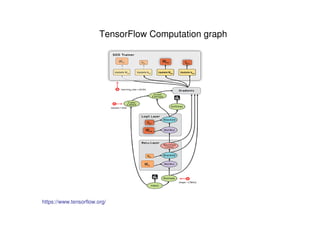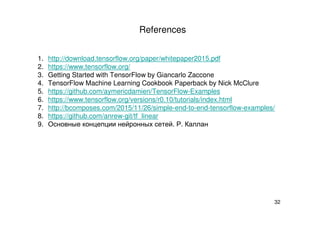TensorFlow example for AI Ukraine2016
- 1. TensorFlow usage Babii Andrii Ph.D. student, Kharkiv National University of Radioelectronics [email protected]
- 2. 2 Motivation 1. Data and model parallelism 2. TensorBoard for visualization 3. Computational graph abstraction 4. Python + Numpy 5. Great documentation and examples 6. More than deep learning framework + Now conception of ‘Python front-end’ for hard backend is trending TinyFlow http://dmlc.ml/2016/09/30/build-your-own-tensorflow-with-nnvm-and-torch.html Syntax (‘Frontend’) like TensorFlow but interpretation is … Torch! NNVM inspired by LLVM… It provides ways to construct, represent and transform computation graphs invariant of how it is executed.
- 3. 3 TensorFlow basic concepts A TensorFlow computation is described by a directed graph , which is composed of a set of nodes Library user construct a computational graph using one of the supported frontend languages (C++ or Python) In a TensorFlow graph, each node has zero or more inputs and zero or more outputs, and represents the instantiation of an operation Values that flow along normal edges in the graph (from outputs to inputs) are tensors - arbitrary dimensionality arrays where the underlying el- ement type is specified or inferred at graph-construction time Special edges, called control dependencies , can also exist in the graph http://download.tensorflow.org/paper/whitepaper2015.pdf
- 4. TensorFlow architecture Python C++ … TensorFlow core execution language CPU GPU Android … There is the client, which uses the session interface to communicate with the master and one or more worker processes Each worker process responsible for arbitrating access to one or more computational devices (such as CPU cores and GPU cards)
- 6. TensorFlow basic concepts. Tensor A Tensor is a typed multi-dimensional array. For example, a 4-D array of floating point numbers representing a mini-batch of images with dimensions [batch, height, width, channel]. In a launched graph: Type of the data that flow between nodes. In the Python API: class used to represent the output and inputs of ops added to the graph tf.Tensor. Instances of this class do not hold data. In the C++ API: class used to represent tensors returned from a Session::Run() call tensorflow::Tensor. Instances of this class hold data. https://www.tensorflow.org/versions/r0.9/resources/glossary.html#glossary
- 7. TensorFlow basic concepts. Operations An operation has a name and represents an abstract computation (e.g., “matrix multiply”, or “add”). An operation can have attributes. •One common use of attributes is to make operations polymorphic over different tensor element types. A kernel is a particular implementation of an operation that can be run on a particular type of device (e.g., CPU or GPU). TensorFlow binary defines the sets of operations and kernels available via a registration mechanism, and this set can be extended by linking in additional operation and/or kernel definitions/registration http://download.tensorflow.org/paper/whitepaper2015.pdf Variable is a special kind of operation that returns a handle to a persistent mutable tensor that survives across executions of a graph.
- 9. 9 TensorFlow. Execution of computation graph Single device (for example we have only one core CPU for computation) The nodes of the graph are executed in an order that respects the dependencies between nodes Multi-device execution •Select device to place the computation for each node in the graph •Managing the required communication of data across device boundaries implied by these placement decisions http://download.tensorflow.org/paper/whitepaper2015.pdf
- 12. 12 TensorFlow. Extensions •Automatic Differentiation – Automatically computes gradients for data flow graphs. •Partial Execution – Allows TensorFlow clients to execute a subgraph of the entire execution graph. •Device Constraints – Allows TensorFlow clients to control the placement of nodes on a device. •Control Flow – Enables support for conditionals and loops in data flow graphs. •Input Operations – Facilitate efficient loading of data into large scale models from the storage system. •Queues – Allow different portions of the graph to execute asynchronously and to hand off data through Enqueue and Dequeue operation. Enqueue and Dequeue operations are blocking. •Containers – The mechanism within TensorFlow for managing longer-lived mutable stat
- 13. 13 TensorFlow. Session A Session object encapsulates the environment in which Tensor objects are evaluated - TensorFlow Docs import tensorflow as tf a = tf.constant(5.0) b = tf.constant(3.0) c = a +b with tf.Session() as sess: print (sess.run(c)) # print(c.eval()) – will do the same (for current opened session) tf.InteractiveSession() is just convenient synonym for keeping a default session open in ipython sess.run(c) is an example of a TensorFlow Fetch
- 14. 14 TensorFlow. Variable Variables are in-memory buffers containing tensors. They must be explicitly initialized and can be saved to disk during and after training TensorFlow Docs import tensorflow as tf weights = tf.Variable(tf.random_normal([100, 150], stddev=0.5), name="weights") biases = tf.Variable(tf.zeros([150]), name="biases") #https://www.tensorflow.org/versions/r0.11/api_docs/python/constant_op.html#random_normal # Pin a variable to GPU. with tf.device("/gpu:0"): v = tf.Variable(...) # Pin a variable to a particular parameter server task. with tf.device("/job:ps/task:7"): v = tf.Variable(...) variable assign zeros, random_normal…
- 15. 15 TensorFlow. Variable Variable initializers must be run explicitly before other ops in your model can be run. The easiest way to do that is to add an op that runs all the variable initializers, and run that op before using the model. - TensorFlow Docs init_op = tf.initialize_all_variables() saver = tf.train.Saver() # Later, when launching the model with tf.Session() as sess: # Run the init operation. sess.run(init_op) ... # Use the model … # Save the variables to disk. save_path = saver.save(sess, "/tmp/model.ckpt") print("Model saved in file: %s" % save_path) Or we can init variable from value of other variable (it should be initialized before): w2 = tf.Variable(weights.initialized_value(), name="w2") tf.train.Saver object have restore method: saver.restore(sess, "/tmp/model.ckpt") https://www.tensorflow.org/versions/r0.11/how_tos/variables/index.html
- 16. 16 TensorFlow. Common syntax examples Fill array with zeros and ones: a = tf.zeros((3,3)), b = tf.ones((3,3)) Sum of array, axis = 1: tf.reduce_sum(a,reduction_indices=[1]) Shape of array: a.get_shape() Re-shape: array: tf.reshape(a,(1,4)) Basic arithmetic: a*3+ 2 Multiplication: tf.matmul(c, d) Element accessing: a[0,0], a[:,0], a[0,:]
- 17. 17 TensorFlow data input How can we input external data into TensorFlow? Simple solution: Import from Numpy: a = np.zeros((3,3)) ta = tf.convert_to_tensor(a) Simple, but does not scale
- 18. 18 TensorFlow data input Use tf.placeholder variables (dummy nodes that provide entry points for data to computational graph). A feed_dict is a python dictionary mapping from tf.placeholder vars (or their names) to data (numpy arrays, lists, etc.) Example: input1 = tf.placeholder(tf.float32) input2 = tf.placeholder(tf.float32) output = tf.mul(input1, input2) with tf.Session()as sess: print(sess.run([output], feed_dict={input1:[6.], input2:[3.]}))
- 19. 19 TensorFlow data input Evaluation: feed_dict={input1:[6.], input2:[3.]} input1 = tf.placeholder(tf.float32) input2 = tf.placeholder(tf.float32) result
- 20. 20 TensorFlow namespaces & get_variable Variable Scope mechanism in TensorFlow consists of 2 main functions: tf.get_variable(<name>, <shape>, <initializer>): Creates or returns a variable with a given name. tf.variable_scope(<scope_name>): Manages namespaces for names passed to tf.get_variable(). Case 1: the scope is set for creating new variables, as evidenced by tf.get_variable_scope().reuse == False. tf.get_varible two cases: Case 2: the scope is set for reusing variables, as evidenced by tf.get_variable_scope().reuse == True.
- 21. 21 Example Problem: Linear regression min)ˆ( 22 →−= ∑∑ yye x x x x x Predicted value Real value Error = Y_predicted – Y_real Y = X*k + b
- 22. 22 Example import numpy as np Import tensorflow as tf # Prepre input data for regression. X from 1 to 100 with step 0.1 # Y = X+ 10*cos(X/5) X_gen = np.arange(100, step=.1) Y_gen = X_gen + 10 * np.cos(X_gen/5) #Number of samples. 100/0.1 = 1000 n_samples = 1000 #Batch size batch_size = 100 #Steps number steps_number = 400 https://github.com/anrew-git/tf_linear
- 23. 23 Example
- 24. 24 Example # Tensorflow is sensitive to shapes, so reshaping without data change # It were (n_samples,), now should be (n_samples, 1) X_gen = np.reshape(X_gen, (n_samples,1)) Y_gen = np.reshape(Y_gen, (n_samples,1)) # Preparing placeholders X = tf.placeholder(tf.float32, shape=(batch_size, 1)) Y = tf.placeholder(tf.float32, shape=(batch_size, 1))
- 25. 25 Example # Define variables to be learned with tf.variable_scope("linear-regression"): k = tf.get_variable("weights", (1, 1), initializer=tf.random_normal_initializer()) b = tf.get_variable("bias", (1,), initializer=tf.constant_initializer(0.0)) y_predicted = tf.matmul(X, k) + b loss = tf.reduce_sum((Y - y_predicted)**2)
- 26. 26 Example # Sample code to solve this problem # Define optimizer properties – optimization type – minimization, variable opt_operation = tf.train.AdamOptimizer().minimize(loss) with tf.Session() as sess: # Initialize Variables in graph sess.run(tf.initialize_all_variables()) # Optimization loop for steps_number steps for i in range(steps_number): # Select random minibatch indices = np.random.choice(n_samples, batch_size) X_batch, y_batch = X_gen[indices], Y_gen[indices] # Do optimization step sess.run([opt_operation, loss], feed_dict={X: X_batch, Y: y_batch})
- 27. 27 Example # Gradient descent loop for steps_number steps for i in range(steps_number): # Select random minibatch batch_indices = np.random.choice(n_samples, batch_size) X_batch, y_batch = X_gen[batch_indices], Y_gen[batch_indices] # Do optimization step sess.run([opt_operation, loss], feed_dict={X: X_batch, Y: y_batch}) Preparing mini-batches Inside sess.run – feed data to TensorFlow
- 28. 28 Example feed_dict={X: X_batch, Y: y_batch}) y_predicted = tf.matmul(X, k) + b loss = tf.reduce_sum((Y - y_predicted)**2) k = tf.get_variable("weights", (1, 1), initializer=tf.random_normal_initializer()) b = tf.get_variable("bias", (1,), initializer=tf.constant_initializer(0.0))
- 29. 29 Example
- 30. 30 TensorFlow auto-differentiation and gradient Automatic differentiation computes gradients without user input TensorFlow nodes in computation graph have attached gradient operations. Use backpropagation (using node-specific gradient ops) to compute required gradients for all variables in graph
- 31. 31 TensorFlow 1. TensorFlow has good computational graph visualization. 2. Support from such a huge company as Google is a plus for TensorFlow. 3. TensorFlow has C++ and Python interfaces. 4. TensorFlow has benefits on large computation problems and distributed heterogeneus computation enviroment 5. TensorFlow not so good on 1-GPU / single host hardware as Theano/Torch 6. TensorFlow base can be extended to the wide range of new hardware
- 32. 32 References 1. http://download.tensorflow.org/paper/whitepaper2015.pdf 2. https://www.tensorflow.org/ 3. Getting Started with TensorFlow by Giancarlo Zaccone 4. TensorFlow Machine Learning Cookbook Paperback by Nick McClure 5. https://github.com/aymericdamien/TensorFlow-Examples 6. https://www.tensorflow.org/versions/r0.10/tutorials/index.html 7. http://bcomposes.com/2015/11/26/simple-end-to-end-tensorflow-examples/ 8. https://github.com/anrew-git/tf_linear 9. Основные концепции нейронных сетей. Р. Каллан
- 33. 33 Questions?





![TensorFlow basic concepts. Tensor
A Tensor is a typed multi-dimensional array. For example, a 4-D array of
floating point numbers representing a mini-batch of images with dimensions
[batch, height, width, channel].
In a launched graph: Type of the data that flow between nodes.
In the Python API: class used to represent the output and inputs of ops added
to the graph tf.Tensor. Instances of this class do not hold data.
In the C++ API: class used to represent tensors returned from a Session::Run()
call tensorflow::Tensor. Instances of this class hold data.
https://www.tensorflow.org/versions/r0.9/resources/glossary.html#glossary](https://image.slidesharecdn.com/aiukraine2016-161008195156/85/TensorFlow-example-for-AI-Ukraine2016-6-320.jpg)







![14
TensorFlow. Variable
Variables are in-memory buffers
containing tensors.
They must be explicitly initialized and can
be saved to disk during and after training
TensorFlow Docs
import tensorflow as tf
weights = tf.Variable(tf.random_normal([100, 150], stddev=0.5), name="weights")
biases = tf.Variable(tf.zeros([150]), name="biases")
#https://www.tensorflow.org/versions/r0.11/api_docs/python/constant_op.html#random_normal
# Pin a variable to GPU.
with tf.device("/gpu:0"):
v = tf.Variable(...)
# Pin a variable to a particular parameter server task.
with tf.device("/job:ps/task:7"):
v = tf.Variable(...)
variable
assign
zeros, random_normal…](https://image.slidesharecdn.com/aiukraine2016-161008195156/85/TensorFlow-example-for-AI-Ukraine2016-14-320.jpg)

![16
TensorFlow. Common syntax examples
Fill array with zeros and ones: a = tf.zeros((3,3)), b = tf.ones((3,3))
Sum of array, axis = 1: tf.reduce_sum(a,reduction_indices=[1])
Shape of array: a.get_shape()
Re-shape: array: tf.reshape(a,(1,4))
Basic arithmetic: a*3+ 2
Multiplication: tf.matmul(c, d)
Element accessing: a[0,0], a[:,0], a[0,:]](https://image.slidesharecdn.com/aiukraine2016-161008195156/85/TensorFlow-example-for-AI-Ukraine2016-16-320.jpg)

![18
TensorFlow data input
Use tf.placeholder variables (dummy nodes that provide entry points for data
to computational graph).
A feed_dict is a python dictionary mapping from
tf.placeholder vars (or their names) to data (numpy arrays, lists, etc.)
Example:
input1 = tf.placeholder(tf.float32)
input2 = tf.placeholder(tf.float32)
output = tf.mul(input1, input2)
with tf.Session()as sess:
print(sess.run([output], feed_dict={input1:[6.], input2:[3.]}))](https://image.slidesharecdn.com/aiukraine2016-161008195156/85/TensorFlow-example-for-AI-Ukraine2016-18-320.jpg)
![19
TensorFlow data input
Evaluation:
feed_dict={input1:[6.], input2:[3.]}
input1 = tf.placeholder(tf.float32) input2 = tf.placeholder(tf.float32)
result](https://image.slidesharecdn.com/aiukraine2016-161008195156/85/TensorFlow-example-for-AI-Ukraine2016-19-320.jpg)






![26
Example
# Sample code to solve this problem
# Define optimizer properties – optimization type – minimization, variable
opt_operation = tf.train.AdamOptimizer().minimize(loss)
with tf.Session() as sess:
# Initialize Variables in graph
sess.run(tf.initialize_all_variables())
# Optimization loop for steps_number steps
for i in range(steps_number):
# Select random minibatch
indices = np.random.choice(n_samples, batch_size)
X_batch, y_batch = X_gen[indices], Y_gen[indices]
# Do optimization step
sess.run([opt_operation, loss],
feed_dict={X: X_batch, Y: y_batch})](https://image.slidesharecdn.com/aiukraine2016-161008195156/85/TensorFlow-example-for-AI-Ukraine2016-26-320.jpg)
![27
Example
# Gradient descent loop for steps_number steps
for i in range(steps_number):
# Select random minibatch
batch_indices = np.random.choice(n_samples, batch_size)
X_batch, y_batch = X_gen[batch_indices], Y_gen[batch_indices]
# Do optimization step
sess.run([opt_operation, loss],
feed_dict={X: X_batch, Y: y_batch})
Preparing mini-batches
Inside sess.run – feed data to TensorFlow](https://image.slidesharecdn.com/aiukraine2016-161008195156/85/TensorFlow-example-for-AI-Ukraine2016-27-320.jpg)















































































